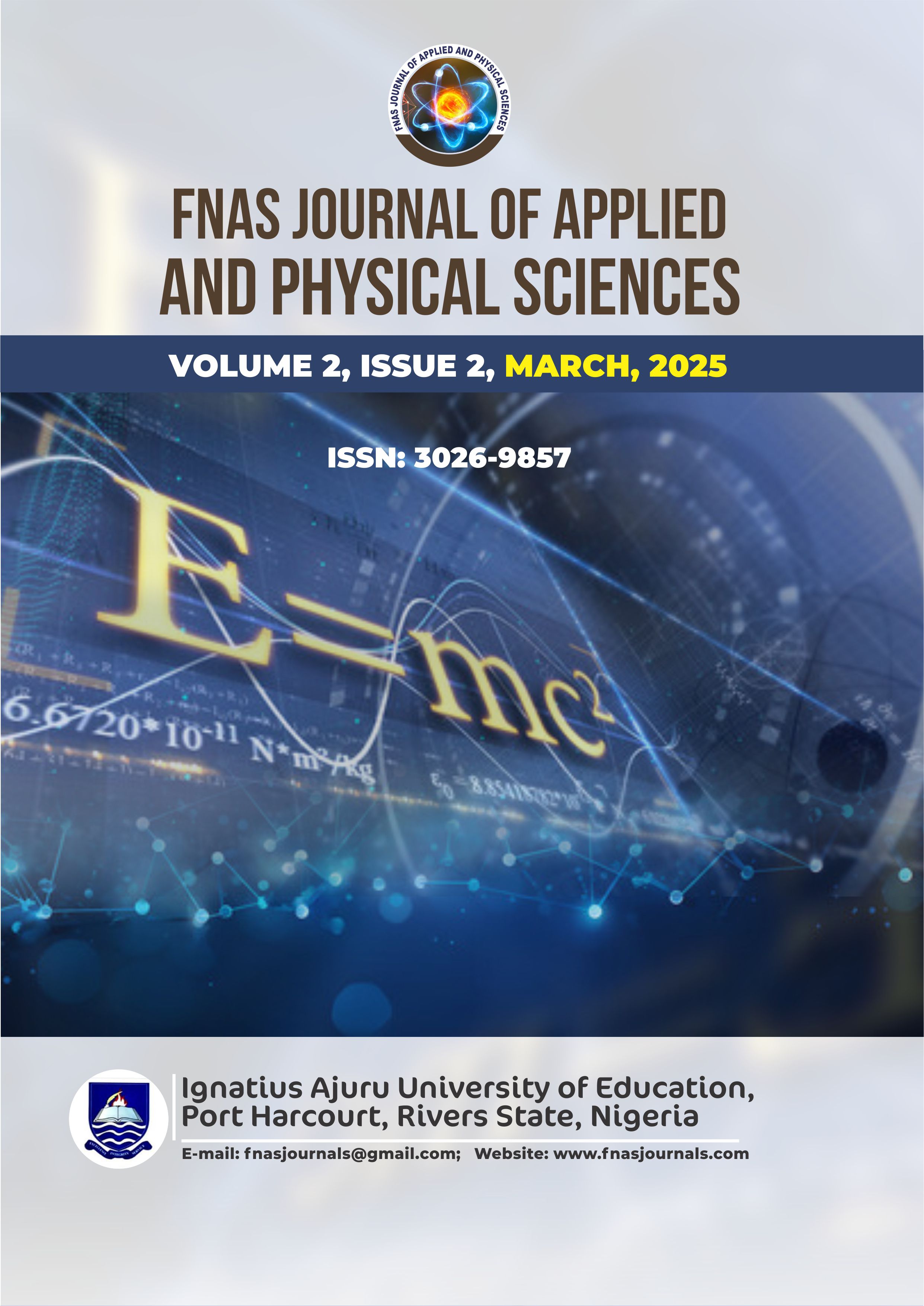AI-Assisted Preparation of Solanum melongena Leaf Extract for Mitigating Corrosion of Mild Steel in Acidic Environments
Keywords:
Corrosion, Mild Steel, Inhibition Efficiency, Electrochemical, AdsorptionAbstract
Artificial Intelligence (AI) and Chemistry applications are mostly focused on preparation, characterization and applications of extracts of natural products in corrosion inhibition, wastewater treatment, biochemical systems, etc. Artificial intelligence can be useful in chemistry and allied field in the areas of compound manufacture and characterization. The present study explores the preparation and unique use of acid extract of Solanum melongena (SM) leaves commonly known as garden egg to truncate deterioration of mild steel in hydrochloric acid and tetraoxosulphate (VI) acid. Mild steel of dimensions 30 mm x 30 mm x 1.4 mm was used for the experiment. It was suspended in the corrodents: 1 mol/L hydrochloric acid and 0.5 mol/L tetraoxosulphate (VI) acid. Acid extract of SM was added as 0.4 g/L, 0.4 g/L and 1.6 g/L concentration, to investigate its effects against dissolution of mild steel by making use of mass loss and electrochemical techniques. The result showed that acid extract of SM effectively truncated the dissolution of mild steel in 1 mol/L of hydrochloric acid and 0.5 mol/L of tetraoxosulphate (VI). The result presented more effectiveness as the concentration increased with prolonged time. Mass loss was reduced more in the 1 M HCl system giving 96.65 % while the 0. 5 mol/L H2SO4 gave 95.85 % inhibitor efficacy, showing good effectiveness for both systems. Polarization experiments revealed a multi-faced character of inhibitor, reducing cathodic, as well as anodic current densities. Surface coverage data using Langmuir adsorption isotherm showed interaction among the adhered substances on the surface of the mild steel with increased surface coverage. The various processes of the preparation, characterization and applications of the leaf extracts are then assigned to AI for any possible relationship in carrying out the processes.
References
Adindu, C. B., Kalu, G., Ikezu, U. P., Ikpa, C. B., & Okeke, P. I. (2024). Molecular docking, ADMET & ADF predictions of Cinnamonum zylanicum for prostate cancer inhibition. Journal of Material Science, Research and Reviews, 7(3), 392–426.
Chen, Y., Li, X., Quiang, Y., Du, G., & Deng, S. (2024). Insights on corrosion mechanism of two rapeseed meal extracts from reflux and ultrasonic methods on cold rolled steel in acetic acid. Colloids and Surfaces A: Physicochemical and Engineering Aspects, 705, 135555.
Choudhary, N., Bharti, R., & Sharma, R. (2021). Role of artificial intelligence in chemistry. Materials Today: Proceedings, 48(11), 58–65.
Deyab, M. A. (2020). Anticorrosion properties of nanocomposites coatings: A critical review. Journal of Molecular Liquids, 313, 113533.
Kruse, L., Wunderlich, N., & Beck, R. (2019). Artificial intelligence for the financial services industry: What challenges organizations to succeed. In Proceedings of the 52nd Hawaii International Conference on System Sciences (pp. 6408–6417).
Manh, T. D., Huynh, T. L., Thi, B. V., Lee, S., Yi, J., & Dang, N. N. (2022). Corrosion inhibition of mild steel in hydrochloric acid environments containing Sonneratia caseolaris leaf extract. ACS Omega, 7, 8874–8886.
Miralrio, A., & Vazques, A. E. (2020). Plant extract as green corrosion inhibitor for different metal surfaces and corrosive media: A review. Processes, 8(942), 1–27.
Nleonu, E. C., Haldhar, R., Godffrey, K. U., Onyemenonu, C. C., Umezunike, A. Z., Okeke, P. I., Mong, O. O., Ichou, H., Arroussse, N., Seong-Cheol, K., Dagdag, O., Ebenso, E. E., & Taleb, M. (2022). Theoretical study and adsorption behaviour of urea on mild steel in automotive gas oil (AGO) medium. Lubricants, 10(157), 3–13.
Oguzie, E. E., Maduabuchi, A. C., Ogukwe, C. E., Oguzie, K. L., & Eneh, N. C. (2011). The adsorption and corrosion inhibiting effect of aqueous extracts of Punica granatum (PNG) on mild steel in 1 M HCl and 0.5 M H₂SO₄. Industrial & Engineering Chemistry Research, 51, 668.
Okeke, P. I., Emeghara, K. C., Ibe, G. C., Oseghale, T. I., Maduka, O. G., & Emereonye, R. U. (2016). Inhibitive action and adsorption character of water extract of Solanum melongena for the corrosion of mild steel in 0.5 M H₂SO₄. IOSR Journal of Applied Chemistry, 9(2), 20–25.
Okeke, P. I., Enemo, E. R., & Ezenwa, T. E. (2019). Mechanism of corrosion inhibition of aluminium in potassium hydroxide using 2.0 M thiourea. IOSR Journal of Applied Chemistry (IOSR-JAC), 12(8), 44–50.
Okeke, P. I., Nleonu, E. C., Hamza, I., Elyor, B., Omar, D., Amanze, K., Adindu, B. C., Nizamuddin, A., Avni, B., & Abeer, A. A. (2024). Chrysophyllum albidum extract as a new and green protective agent for metal. Canadian Metallurgical Quarterly, The Canadian Journal of Metallurgy and Materials Science, 1–16.
Okeke, P. I., Odilora, C. A., & Chukwu, P. I. (2020). Electrochemical investigation of the corrosion of aluminium in KOH by urea with KI as a synergistic agent. Journal of Applied Chemistry, 131(12), 55–61.
Radha, K. V., Deepanshu, P., Varshith, V. N., & Dharmaraj, S. (2024). Experimental study on corrosion inhibition of mild steel using Mukia maderaspanshu leaves extract as green inhibitor. Surface Science and Technology, 2(27), 1–10.
Salim, A. M., Dawood, M. N., & Ghazi, R. (2020). Pomegranate peel plant extract as potential corrosion inhibitor for mild carbon steel in a 1 M HCl solution. Materials Science and Engineering, 987(012019), 1–18.
Segler, M. H. S., Preuss, M., & Waller, M. P. (2018). Planning chemical synthesis with deep network and symbolic AI. Nature, 555, 604.
Sulaimon, A. A., Murungi, P. I., Tackie-Otoo, B. N., Nwankwo, P. C., & Bustam, M. A. (2023). Analysis of natural okro extracts as corrosion inhibitors for mild steel in acidic medium. Environmental Science and Pollution Research International, 30(56), 119309–119328.
Thakkar, A., Chadimová, V., Bjerrum, C., & Reymond, J. (2021). Retrosynthetic accessibility score (RAscore) – Rapid machine-learned synthesizability classification from AI-driven retrosynthetic planning. Chemical Science, 12, 3339.





